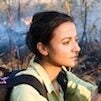Julia Kumari Drapkin is on the cutting edge of environmental journalism. “We’re doing climate change journalism in a totally different way.” A 2007 alumna of Metcalf Institute’s Diversity Fellowship in Environmental Reporting, Drapkin is the executive producer of iSeeChange, a crowdsourced public media experiment that connects average citizens with scientists to help them understand the changes happening in their own backyards. “This is a real opportunity to have two-way learning where we can all benefit,” said Drapkin.
Instead of taking the traditional approach to covering climate, which typically begins with an interview with a scientist, Drapkin seeks observations and questions from residents to find out how they are experiencing environmental change in their daily lives. She talks to people about unusual occurrences in their neighborhoods such an increase in squirrel populations, strange animal behavior, unusual weather events, or early flower blooms. Then, in a form of reverse reporting, Drapkin connects citizens to scientists to answer questions about what they are observing.
“The goal of iSeeChange is to connect people to each other and the changing environment,” said Drapkin. “It’s a frank conversation between an iSeeChange audience member and scientists.”
Drapkin says her Metcalf experience taught her the value of interacting with researchers as real people, not just anonymous authority figures. The 10-month fellowship, designed for early-career minority reporters, included an intensive month of independent study at URI’s Graduate School of Oceanography followed by a nine-month environmental reporting assignment at one of two dozen partnering news organizations.
“It was an incredible opportunity,” said Drapkin. “It totally changed my life.” Drapkin also values the network of journalists she met through her fellowship. “I can literally point to seven or eight people with a connection to Metcalf who have monumentally influenced my career,” she said.
Drapkin has reported for a wide range of news organizations throughout her career including PRI’s The World, Global Post, and Time.com. She currently reports for the Times-Picayune in New Orleans, where she recently wrote a series of stories about how a coffee fungus in Central America is impacting illegal immigration in New Orleans and the U.S.
In addition to her work at the Times-Picayune, Drapkin continues to push iSeeChange to new levels. She’s now partnering with NASA’s OCO-2 Mission and Berkeley Atmospheric C02 Observation Network on the next phase of the project that complements ongoing efforts to measure atmospheric carbon dioxide via satellite and sensors in the Bay Area. Drapkin has brought on 6 new public media partners to participate.
Additionally, iSeeChange and NASA’s OCO-2 Mission are developing a cell phone app that would make it possible for the iSeeChange audience to sync what they’re seeing in their backyards to data NASA is capturing from space.
Drapkin says the goal of the initiative is to create a citizen science storycorps, a project that promises to open up a new world of possibilities for crowdsourced climate change reporting with satellites and sensor data.
Since first reporting on climate change 7 years ago as a Metcalf fellow, Drapkin realized that everybody wants to know the same thing: “How their individual experience fits in the big picture.”
For the first time the technology exists to begin to figure that question out which “makes it one of the most exciting times to be a journalist,” Drapkin added.
Read More Alumni Profiles

